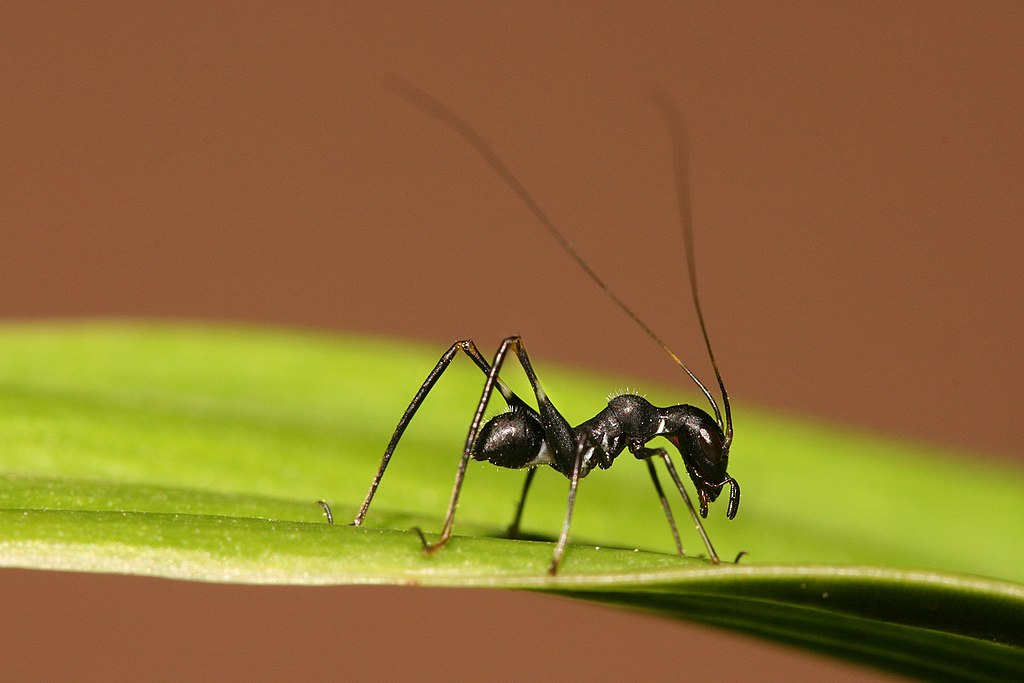
Batesian mimicry
Young instars of some Orthoptera, such as the bush cricket Macroxiphus sumatranus, have an “uncanny resemblance” to ants, extending to their black coloration, remarkably perfect antlike shape, and convincingly antlike behaviour. Their long antennae are camouflaged to appear short, being black only at the base, and they are vibrated like ant antennae. Larger instars suddenly change into typical-looking katydids, and are entirely nocturnal, while the adult has bright warning coloration.
Gwynne, Darryl T. (2001). Katydids and Bush-crickets: Reproductive Behavior and Evolution of the Tettigoniidae. Cornell University Press. p. 80. ISBN 978-0-8014-3655-0.
Macroxiphus is a small genus of bush crickets or katydids distributed in Southeast Asia and Micronesia.
Pictet (1888) Mem. Soc. Phys. Hist. Nat. Geneve 30(6): 52.
Tactile mimicry
Tactile mimicry is found in the cricket Myrmecophilus acervorum; its relationship with ants was first studied by Paolo Savis in 1819. It has many ant species as hosts, and occurs in large and small morphs suited to large hosts like Formica and Myrmica, and the small workers of species such as Lasius. On first arriving in an ants’ nest, the crickets are attacked by the workers, and are killed if they do not run fast enough, but within a few days they adjust their movements to match those of their hosts, and are then tolerated. Mimicry appears to be achieved by a combination of “social releasers”, whether by imitating “solicitation signals” with suitable behaviour or ant pheromones with suitable chemicals; Hölldobler and Wilson (1990) propose that Wasmannian mimicry be redefined to permit any such combination.
Hölldobler, Bert; Wilson, Edward O. (1990). The Ants. Harvard University Press. pp. 511–514. ISBN 978-0-674-04075-5.
Myrmecophilus acervorum is an orthopteran insect belonging to the family Myrmecophilidae (the ant-loving crickets). This continental European species is probably the most widespread and most frequently encountered member of this rather obscure family found in Europe. It is also by far the smallest orthopteran found in Western Europe, with its total adult length never exceeding 3.5 mm (0.14 in).
Field Guide to the Grasshoppers and Crickets of Britain and Northern Europe, Heiko Bellman (1985, Translated from German 1988) ISBN 0-00-219852-5
As with other members of the family, this insect lives its whole lifecycle as an inquiline within ants‘ nests. M. acervorum is known to live with more than 20 different ant species. This specialized way of life has led this insect and its relatives to evolve many morphological differences compared to other orthopterans, including complete absence of wings (as they never leave their host nest) and hearing organs (as they no longer use stridulation), and much reduced eyesight, as well as their very small size.
These tiny insects are dark brown with paler bands and prominent cerci, which serve as their primary sensory organs. Adults are found throughout the year, and take up to two years to reach adulthood from hatching. In this species, the females reproduce parthenogenetically.

Leave a Reply